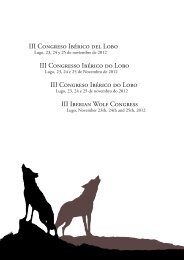Bison-Rewilding-Plan-2014
Bison-Rewilding-Plan-2014
Bison-Rewilding-Plan-2014
- No tags were found...
Create successful ePaper yourself
Turn your PDF publications into a flip-book with our unique Google optimized e-Paper software.
individuals. Young bulls exchange most frequently(Krasinska et al. 1999). A cow is the leader of a mixedgroup, usually a female with a calf. It has not beenestablished whether leadership is permanent,although marked cows have been observed to beleaders up to the age of 20. However, since changesin the structure and size of groups are frequent, newarrangements in the hierarchy may occur (Krasinskaet al. 1999).According to the data from the Pedigree Book,European bison bulls living in captivity begin tomature sexually in the second year of life. <strong>Bison</strong>living in free-ranging populations and large reservesbegin to sexually mature slightly later at the age ofthree, although they do not participate in reproductionuntil the age of six to seven. The reproductiveperiod in males is short, usually lastingfrom six to 12 years of age. Ecological observationssuggest limited participation of old bulls in reproduction(Krasinska et al. 1999).Female bison usually become sexually mature inthe third year of their life, giving birth to the first calfin the fourth year, although this can vary. In general,females breed every second year and produce onlyone calf at a time. Females can breed until the endof their life; the limit in a free-ranging population isusually around 20 years of age although in captivitycows older than 20 years have been known to givebirth. A cow will have approximately nine calvesthroughout its breeding life.The rutting season in a free-ranging populationlasts from August to October. During the ruttingseason a larger number of solitary bulls areobserved due to the increased mobility of malessearching for rutting cows. The average time a malemight stay with a group is six days; one marked bullin the Bialowieza forest visited six groups duringone rutting season. The same study revealed thatduring the rutting period cows remained in thesame territory and did not move to search for bulls(Krasinksa et al. 1999).During the rut bulls become aggressive, especiallytowards younger adult bulls. They demonstratetheir strength by breaking young trees, pawingthe ground with their forefeet and wallowing.Although wallowing can be observed in animalsof both sexes throughout the year as a groomingbehaviour, in the rutting period it also forms partof the sexual behaviour of bulls. The bison choosesandy hills, gravel-pits, sandy roads, and roadsidesfor wallowing. When a female is in heat bulls mayengage in brief but intense fights. Often even theRUUD MAASKANT / ARK NATURE13



